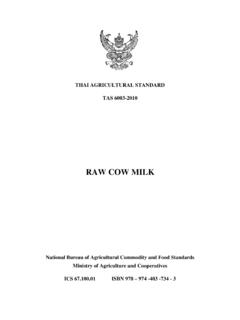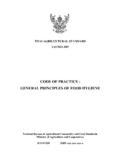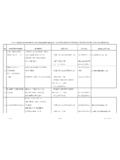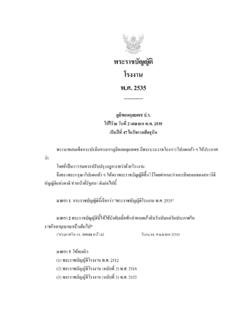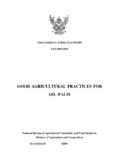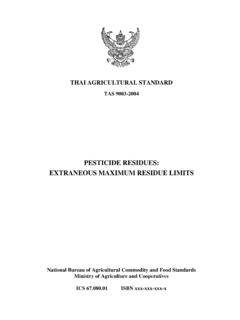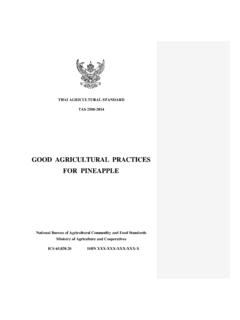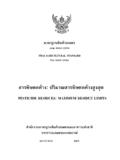Transcription of ASPARAGUS - ACFS
1 THAI AGRICULTURAL STANDARD TAS 1500-2004 ASPARAGUS National Bureau of Agricultural Commodity and Food Standards Ministry of Agriculture and Cooperatives ICS ISBN 978-974-403-542-4 UNOFFICAL TRANSLATION THAI AGRICULTURAL STANDARD TAS 1500-2004 ASPARAGUS National Bureau of Agricultural Commodity and Food Standards Ministry of Agriculture and Cooperatives 50 Phaholyothin Road, Ladyao, Chatuchak, Bangkok 10900 Telephone (662) 561 2277 Published in the Royal Gazette Section 63D, dated 7 June (1)Working Group on the Elaboration of Standards for ASPARAGUS , Peppers, Okra, Tomato, Chinese parsley 1. Chairperson of the Working Group Thongjiem (Senior Expert in Crop Production) 2. Representative of the Department of Internal Trade 3. Representative of the Department of Export Promotion Homasvin 4.
2 Representative of the Department of Cooperative Promotion 5. Representatives of the Horticulture Research Institute, Department of Agriculture Bansiddhi Sittipoch 6. Representatives of the Plant Protection Research and Development Office, Department of Agriculture Keinmeesuke Kongsangdao Thammakijjawat 7. Representatives of the Institute of Research and Development on Agricultural Production Science, Department of Agriculture Poomongkutchai 8. Representative of the Postharvest and Product Processing Research and Development, Department of Agriculture 9. Representative of the Bureau of Agricultural Product Quality Development, Department of Agricultural Extension Sunthornphak 10.
3 Representative of the Office of Commodity and System Standards, National Bureau of Agricultural Commodity and Food Standards Sukontarug 11. Representative of the Vegetable, Flower and Herb Promotion Division, Department of Agricultural Extension Dissataporn 12. Representative of the Faculty of Agriculture, Kasetsart University Assistant Professor Sutevee Sukprakarn 13. Representative of the Faculty of Agriculture, Khon Kaen University Assistant Professor Suchila Techawongstien 14. Representative of the Faculty of Agriculture, Chiang Mai University 15. Representative of the Faculty of Natural Resources, Price of Songkla University (2)16. Representative of the Federation of Thai Industries 17. Representative of the Thai Food Processors Association Hui Lee 18.
4 Experts Kosiyachinda Expert of the Postharvest and Quality of Vegetable and Fruit Yolprasarn Representative of the Taniyama Siam Company Limited Withunwitalak Representative of the Phak Doctor Company Limited Sitadhani Representative of the Tropical Vegetable Research Center, Kasetsart University 19. Representative of the National Bureau of Agricultural Commodity and Food Standards Pradyabumrung Secretary 20. Representative of the National Bureau of Agricultural Commodity and Food Standards Apinyanuwat Assistant Secretary (3) ASPARAGUS is produced in Thailand and an important export commodity of the country. In order to provide the Thai ASPARAGUS with better acceptance by both national and international levels in term of food safety for consumers and export promotion.
5 The Ministry of Agriculture and Cooperatives deems it proper to establish a standard for ASPARAGUS . The provisions of this standard are based upon the information of the following document: FAO/WHO. 1999. Codex Alimentarius Volume 5B. Fresh Fruits and Vegetables, CODEX STANDARD FOR ASPARAGUS (CODEX STAN 225-2001). Joint FAO/WHO Food Standard Programme, FAO, Rome. 6p. Remark: The standard title has been revised from Thai Agricultural Commodity and Food Standard (TACFS) to Thai Agricultural Standard (TAS) in accordance with the enforcement of the Agricultural Standards Act 2551 (2008). NOTIFICATION OF THE NATIONAL COMMITTEE ON AGRICULTURAL COMMODITY AND FOOD STANDARDS SUBJECT: ASPARAGUS 2547 (2004) It is appropriate to establish the national standard for ASPARAGUS for the benefit of quality improvement, trade facilitation and consumer protection.
6 Therefore, the National Committee on Agricultural Commodity and Food Standards notifies the establishment of Thai Agricultural Commodity and Food Standard entitled ASPARAGUS to be used as a voluntary standard as attached herewith. Notified on 26 April (2004) Somsak Thepsutin Minister of Agriculture and Cooperatives Chairperson of the National Committee on Agricultural Commodity and Food Standards TAS 1500-2004 THAI AGRICULTURAL STANDARD ASPARAGUS 1. DEFINITION OF PRODUCE This standard applies to commercial varieties of ASPARAGUS grown from ASPARAGUS officinalis L. of the Liliaceae family to be supplied fresh to the consumer, after preparation and packaging. ASPARAGUS for processing is excluded. The ASPARAGUS under this standard is classified into 4 groups by colour of the shoots: white; purple (white shoot, pink or purplish pink shoot tip); green with purple; green (majority of the shoot and shoot tip are green); This standard does not apply to ASPARAGUS of less than 3 mm.
7 Diameter. 2. PROVISIONS CONCERNING QUALITY MINIMUM REQUIREMENTS In all classes, subject to the special provisions for each class and the tolerances allowed, the ASPARAGUS must be: whole and fresh ; neither bent nor stunted ; free of prominent abrasion and bruises ; clean, practically free of any visible foreign matter ; practically free of pests affecting the general appearance of the produce ; practically free of damage caused by pests ; the cut at the base of the shoots must be clean ; free of any foreign smell and/or taste ; free of abnormal external moisture, excluding condensation following removal from cold storage ; The ASPARAGUS must be properly harvested, postharvest handled, stored and transported in order to obtain proper size and quality, and to arrive in satisfactory condition at the place of destination.
8 TAS 1500-2004 CLASSIFICATION ASPARAGUS is classified in three classes defined below: Extra class ASPARAGUS in this class must be of superior quality, straight with compact tip. Shoots are free of woody fibers. No defects due to pests and diseases. However, slight defects that are easily removable by the consumer are allowed. Cut at the base of the shoots must be smooth and as square as possible. Green ASPARAGUS should be a minimum of 95% green in colour of the shoot length, whereas the white shoots must be white throughout: however, light purplish- pink tip may be allowed. Class I ASPARAGUS in this class must be of good quality. The shoots may be slightly curved with compact tips. Slight amount of woody fibers at the peel of the base may be allowed. No defects due to pests and diseases.
9 However, slight defects that are easily removable by the consumer are allowed. Cut at the base of the shoots must be smooth and as square as possible. Green ASPARAGUS should be a minimum of 80% green in colour of the shoot length, whereas light- purplish pink colour may be allowed on the tip and shoot of white ASPARAGUS . Class II This class includes shoots which do not qualify for inclusion in the higher classes but satisfy the minimum quality requirements specified in section above. The shoots may be curved. Scale leaves at the tip may be split, but no lateral shoot growth is evident. Small amount of woody fibers at the peel of the base is allowed. Slight defects due to non-pathogenic factor may be allowed at the shoot base that they are easily removable by the consumer. Cut at the base of the shoots may be slightly slant.
10 Green ASPARAGUS should be a minimum of 60% green in colour of the shoot length, whereas other colours may be allowed on the tip of white ASPARAGUS . 3. PROVISIONS CONCERNING SIZING Size is determined by the length and diameter of the shoot as follows: SIZING BY LENGTH All quality classes are classified into 3 sizes as follows Long : L, ASPARAGUS is longer than 17 cm Short : S, ASPARAGUS is between 12-17 cm Tip : T, ASPARAGUS is shorter than 12 cm TAS 1500-2004 SIZING BY DIAMETER The diameter of the shoots of 25 cm long shall be measured at the widest part of the cut end. Diameter sizing is classified into 4 sizes as follows: Size Code Diameter at the base (mm) 1 > 10 2 > 8 10 3 > 6 - 8 4 3 6 It is noted that when the shoots are trimmed for packaging, the shoot diameters vary according to the shoot length.
